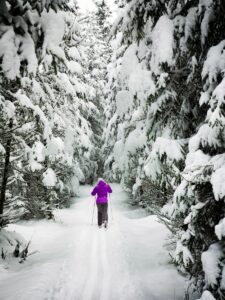When it comes to conquering the trails during colder months, knowing what to wear for cold weather trail running is essential for a safe and enjoyable experience. Cold weather running presents unique challenges, from fluctuating temperatures to unpredictable conditions like snow and ice. This comprehensive guide will break down the key components of cold weather running gear to keep you warm, dry, and comfortable on your winter runs.
What to Wear for Cold Weather Trail Running
Base Layer: Wicking Away Moisture
The foundation of your cold weather running attire should be a moisture-wicking base layer. Look for materials like merino wool or synthetic fabrics that efficiently pull sweat away from your skin, keeping you dry and preventing chills caused by damp clothing. A long-sleeve shirt or women’s tights make excellent choices for this first layer.

Mid Layer: Insulating for Extra Warmth
The mid layer is responsible for retaining body heat. Opt for clothing with insulating properties, such as fleece-lined tops or running tights designed for colder temperatures. This layer serves as a crucial buffer between your base and outer layers, providing essential warmth during colder weather runs.
Outer Layer: Shielding from the Elements
Your outer layer should act as a barrier against wind, rain, and snow. A waterproof jacket with an adjustable hood offers vital protection in wet weather conditions. Look for features like chest pockets for easy access to essentials and ventilation options for temperature regulation.
Protecting Extremities
Head Warmers and Ear Warmers
To maintain comfort and focus, keep your head and ears warm. Consider wearing a hat or headband made of moisture-wicking material. Ear warmers are an excellent addition for extra protection against chilly air, ensuring you stay warm and focused on the trail.
Winter Running Gloves
Invest in a pair of winter-specific running gloves with synthetic insulation. These gloves are designed to keep your hands warm while still allowing for dexterity, a crucial aspect of trail running. Look for options with touch-screen compatibility if you need to use your phone or GPS during your run.

Waterproof Running Shoes
Footwear is paramount in ensuring a safe and comfortable trail run in colder conditions. Opt for waterproof running shoes to keep your feet dry and warm. Look for shoes with good traction for navigating potentially slippery terrain. If temperatures drop significantly, consider adding insulating insoles for extra protection.
Traction Devices for Snow and Ice
In icy or snowy conditions, traction devices are a game-changer. They provide additional grip and stability, reducing the risk of slips and falls. Consider investing in slip-on spikes or traction cleats that can be easily added to your shoes when needed, making a huge difference in your confidence and safety on the trails.
Additional Accessories for Cold Weather Trail Running
Running Vest for Core Warmth
A running vest can be a valuable addition to your cold weather running gear. It provides an extra layer of insulation for your core without restricting your arm movement. Look for options with breathable panels to prevent overheating.
Running Belt for Essentials
Carrying essentials like energy gels, a phone, or keys is important even in colder conditions. A running belt with multiple pockets can help you keep your items organized and easily accessible, ensuring you have everything you need during your run.
Adapting to Changing Conditions
Removing Layers as Needed
As your body temperature rises during a run, it’s important to have the flexibility to remove layers to prevent overheating. Garments with zippers or half-zips allow for easy ventilation, and lightweight options can be tied around your waist if needed.
Adjusting for Wind Chill
Cold weather runs, wind chill can make a significant impact on perceived temperature. If you’re facing windy conditions, consider adding an extra layer or a windproof outer shell to your ensemble to provide extra protection against the biting cold.
Final Thoughts: Mastering Cold Weather Trail Running
Cold weather trail running doesn’t have to be a daunting endeavor. With the right winter running gear and a strategic layering approach, you can conquer the trails even in freezing temperatures. Remember to prioritize moisture-wicking materials, insulating layers, and protective outerwear. Don’t forget to pay attention to your extremities and invest in quality footwear and traction devices for added safety. By staying warm, dry, and comfortable, you’ll be able to fully enjoy the invigorating experience of trail running even in the coldest of conditions.
- What Exercises Improve Trail Running
- What Is A Good Trail Running Pace
- What Is A Recovery Run
- What Is Different About Trail Running Shoes
- What Is Technical Trail Running
- What Is The Best Dog Breed For Trail Running
- What Is The Difference Between Running And Trail Running Shoes
- What Is The Most Iconic Trail Running Race
- What Is Trail Running
- What Size Hydration Pack Do I Need
- What To Eat Before Trail Running
- What To Eat During Trail Running Revealed
- What To Wear For Cold Weather Trail Running
- What To Wear For Trail Running The Essentials You Need
